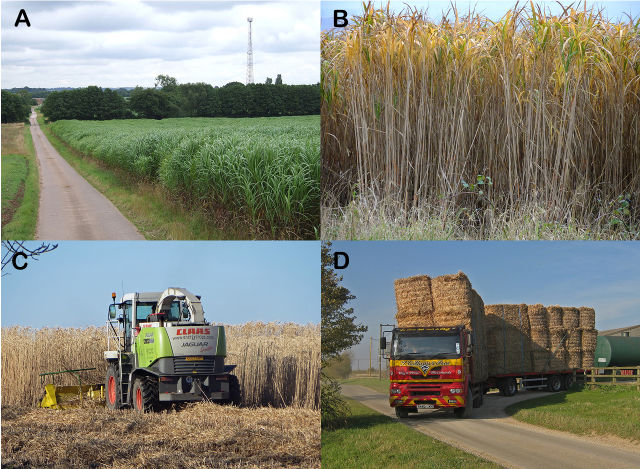Miscanthus Biomass Yields: Difference between revisions
Jump to navigation
Jump to search
No edit summary |
(various edits; made figure, inserted it.) |
||
| Line 1: | Line 1: | ||
[[File:Miscanthus figure.jpg|640px|thumb|right| (A) Miscanthus crop; (B) Miscanthus grass grown as bio-fuel, height is about 6-7ft.; (C) Harvesting; (D) Miscanthus bales being transported for biofuel production. ]] | |||
Elephant Grass | [https://en.wikipedia.org/wiki/Miscanthus_giganteus Miscanthus giganteus] (Elephant Grass) is a crop with multiple uses, such as biofuels, bedding, cover crop and for plastics and [[nanocellulose]]. One acre of it yields 3 tons dry biomass per acre under typical US agricultural practices. Per hectare, this dry matter yield has an energy equivalent of 36 barrels of crude oil or about 10000 liters of fuel oil - and this every year. Miscanthus does not require fertilizer, and is insensitive to diseases. It does not need to be replanted every year (once planted, it lasts 20 years). | ||
http://bioenergy.ornl.gov/papers/miscanthus/miscanthus.html | ==Processing== | ||
Miscanthus can be processed to (cellulosic) [[ethanol]]. It can also be turned into other biofuels via [[pyrolysis]]. | |||
==Open Source Equipment Needs== | |||
* Tractor | |||
* Special implements | |||
==Links== | |||
* http://bioenergy.ornl.gov/papers/miscanthus/miscanthus.html | |||
[[Category:Food and Agriculture]] | |||
[[Category:Biofuel]] | |||
Revision as of 16:19, 17 July 2016
Miscanthus giganteus (Elephant Grass) is a crop with multiple uses, such as biofuels, bedding, cover crop and for plastics and nanocellulose. One acre of it yields 3 tons dry biomass per acre under typical US agricultural practices. Per hectare, this dry matter yield has an energy equivalent of 36 barrels of crude oil or about 10000 liters of fuel oil - and this every year. Miscanthus does not require fertilizer, and is insensitive to diseases. It does not need to be replanted every year (once planted, it lasts 20 years).
Processing
Miscanthus can be processed to (cellulosic) ethanol. It can also be turned into other biofuels via pyrolysis.
Open Source Equipment Needs
- Tractor
- Special implements
